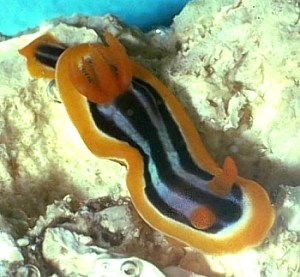
Chromodoris quadricolor
(Ruppell & Leuckart,, 1828)
Order: NUDIBRANCHIA
Suborder: DORIDINA
Superfamily: EUDORIDOIDEA
Family: Chromodorididae
DISTRIBUTION
Western Indian Ocean
PHOTO
UPPER RIGHT: Pangavini Bch, off Kunduchi Bch, Dar es Salaam, Tanzania, 30mm long alive, Oct 1976. Photo: Bill Rudman.
LOWER LEFT: Gulf of Aquaba, Red Sea. Photo: Bernard Picton.
LOWER RIGHT: Bongoyo Is, off Kunduchi bch, Dar es Salaam, Tanzania, 40mm long alive, 12 Nov 1976. Photo: Bill Rudman.
RELATED TOPIC
One of a group of similarly coloured species. It has a thin pale, almost white band at the mantle edge then a broad band of orange. Inside the orange there is a thin white band which becomes broader around the anterior end. In the central region there are three broad black bands and two thinner dirty blue lines. The gills and rhinophores are translucent orange. I will try and find time to prepare a comparative page on the 'Chromodoris quadricolor colour group'.
References:
• Rudman, W.B. (1977) Chromodorid opisthobranch Mollusca from East Africa and the tropical West Pacific. Zoological Journal of the Linnean Society, 61: 351-397.
• Rudman, W.B. (1982) The Chromodorididae (Opisthobranchia: Mollusca) of the Indo-West Pacific: Chromodoris quadricolor, C. lineolata and Hypselodoris nigrolineata colour groups. Zoological Journal of the Linnean Society, 76: 183-241.
• Rudman, W.B. (1984) The Chromodorididae (Opisthobranchia: Mollusca) of the Indo-West Pacific: a review of the genera.Zoological Journal of the Linnean Society, 81: 115-273.
• Rüppell, E. & Leuckart, F.S. (1830 or 31) Neue wirbellose Thiere des Rothen Meeres. Atlas zu der Reise im nördlichen Afrika von Eduard Rüppell. Brunner, Frankfurt am Main. 23-50, pls 7-12 pages.
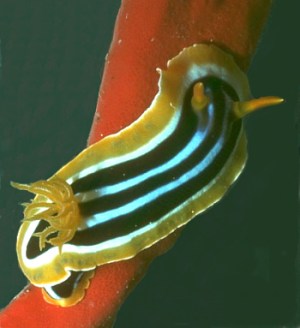
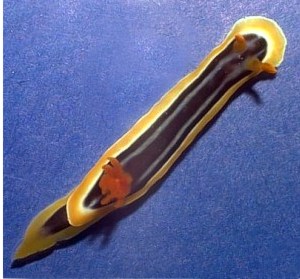
Rudman, W.B., 2001 (January 8) Chromodoris quadricolor (Ruppell & Leuckart,, 1828). [In] Sea Slug Forum. Australian Museum, Sydney. Available from http://www.seaslugforum.net/find/chroquad
Related messages
Re: Abnormalities in Chromodoris quadricolor
May 7, 2009
From: Joe De Vroe
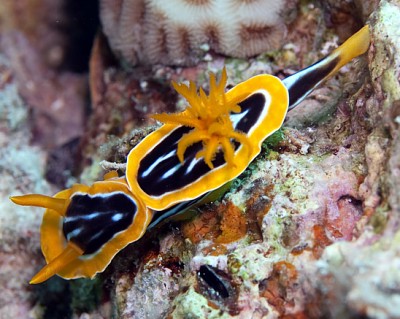
Concerning message #20343:
Strange malformation of Chromodoris quadricolor ...
Locality: Fanadir, 12 m, El Gouna, Red Sea, 03 April 2009. Length: 6 cm. Photographer: Joe De Vroe.
Joe De Vroe
joe.devroe@skynet.be
De Vroe, Joe, 2009 (May 7) Re: Abnormalities in Chromodoris quadricolor. [Message in] Sea Slug Forum. Australian Museum, Sydney. Available from http://www.seaslugforum.net/find/22409Thanks Joe,
It is certainly one for the Abnormalities List. I suspect you are right in identifying this as C. quadricolor but perhaps it is Chromodoris africana ? That species has no sign of blue and the black dominates over the white. Usually you can tell by the much wider mantle skirt in C. africana but in this malformed specimen it is a bit hard to be sure.
Best wishes,
Bill Rudman
Chromodoris quadricolor & black sponge
July 2, 2008
From: Kamal El Tawil
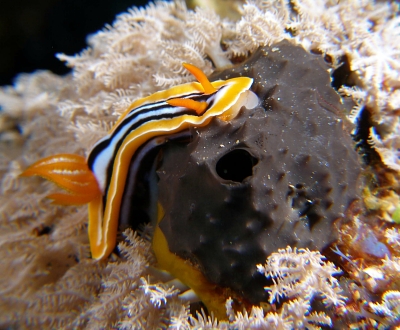
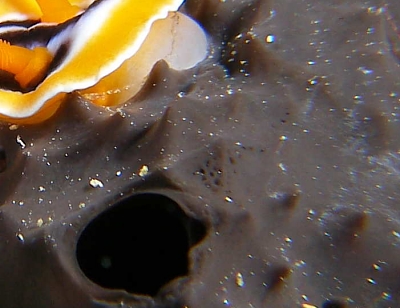
Dear Bill,
Another case of Chromodoris quadricolor feeding on black sponge ! In the past year or so several cases of C. quadricolor feeding on this black sponge were reported in contradiction to belief that they only fed on a red sponge. Would you say such cases were not observed through the years or are these slugs undergoing a change in their feeding habits ?
Locality: Habili Ali, St. John's reefs, 15 metres, Egypt, Red Sea, 21 June 2008, Submerged offshore reef - wall. Length: 40 mms. Photographer: Kamal El Tawil.
Kind regards,
Kamal el Tawil
www.coralworld.net
kamal@coralworld.net
El Tawil, K., 2008 (Jul 2) Chromodoris quadricolor & black sponge. [Message in] Sea Slug Forum. Australian Museum, Sydney. Available from http://www.seaslugforum.net/find/21662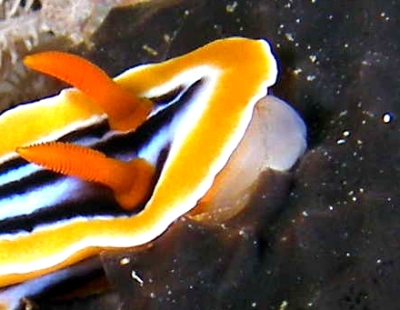
Dear Kamal,
Thanks for this interesting observation. When you first sent photos of C. quadricolor on this blackish sponge [message #20150] I explained why I thought it was an interesting find - although anomalous - so it is really good to get further reports, as this shows that what could have been a strange anomaly is probably part of the species' normal diet.
To answer your question about whether it is perhaps changing its diet. I suspect that these grey-black thorectid sponges are part of its usual diet. I suspect the reason we only had reports of it on red sponges [Negombata spp but often misidentified as Latrunculia spp] was because these sponges often occur in an erect branching form, are brightly coloured, and with a few Chromodoris quadricolor crawling on them present an irresistible photo opportunity. Hopefully my constant, if not irritating, requests for photos of animals 'doing things' is beginning to bear fruit, and shows that the eye of a photographer is just as useful as the eye of a trained scientist when it comes to recording new feeding observations.
Interestingly, when you look at the feeding in the Chromodorididae as a whole, it is the choice of the red sponge by C. quadricolor, which is anomalous . Most chromodorids feed on sponges of the Dictyoceratida and Dendroceratida, while the red sponge belongs in the unrelated Poecilosclerida. The link between the grey-black sponge, which is a dictyoceratid, and the red sponge, is that they both contain a unique group of molecules called latrunculins which C. quadricolor stores in its mantle glands for defensive purposes. We could hypothesise that those chromodorids, such as C. quadricolor, which feed on these red poecilosclerid sponges, are expanding their food choice from their 'ancestral' food sponges, to other sponges with the same or similar chemicals.
Best wishes,
Bill Rudman
Another Chromodoris africana from Tofo, Mozambique
April 28, 2008
From: Natasja Vandeperre
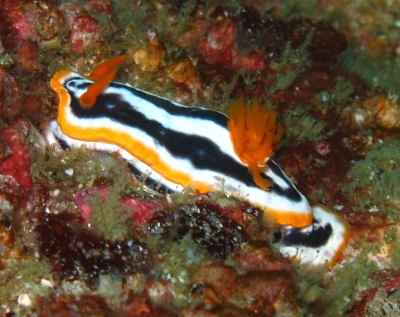
Dear Bill,
Here is another Chromodoris africana from Mozambique.
Locality: Tofo, Mozambique, Indian Ocean, 22 July 2007. Length: 30 mm. Photographer: Natasja Vandeperre.
Greetings,
Natasja
postmaster@naaktslakken.be
Natasja Vandeperre, 2008 (Apr 28) Another Chromodoris africana from Tofo, Mozambique. [Message in] Sea Slug Forum. Australian Museum, Sydney. Available from http://www.seaslugforum.net/find/20579Dear Natasja,
When trying to make sense of some of the strange colour forms of this group of similarly coloured species, I sometimes have doubts about the validity of some species - for example are C. africana and C. quadricolor really different? So it is reassuring to get photos of typical Chromodoris africana like this, which show how its colour pattern [black, white and orange only]and its body shape, with a wider mantle skirt and softer wider body, differ from C. quadricolor.
Best wishes,
Bill Rudman
Re: Chromodoris quadricolor and the cowrie
December 4, 2007
From: Vittorio Bruzzone
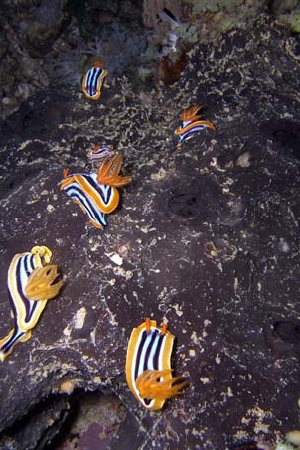
Concerning message #21197:
Dear Bill,
Thanks a lot for your reply.
Here are some photos of groups of Chromodoris quadricolor from the same dive on the same sponge
Locality: Jeddah, 10 meters, Saudi Arabia, Red Sea, 19 November 2007. Length: 30 mm. Photographer: Vittorio Bruzzone.
Vittorio Bruzzone
vittorio@bruzzone.it
Bruzzone, V., 2007 (Dec 4) Re: Chromodoris quadricolor and the cowrie. [Message in] Sea Slug Forum. Australian Museum, Sydney. Available from http://www.seaslugforum.net/find/21254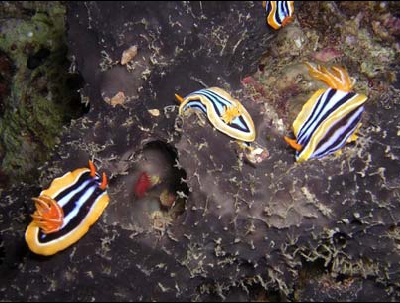
Dear Vito,
Thanks for these extra photos of C. quadricolor on this dark grey sponge, which is almost certainly a species of Semitaspongia. The only way we can be 100% sure a nudibranch is eating a particular food is to find it actually eating a hole in the food. This is not always possible, but when I see a large number of animals together like this, I can be pretty sure that they are attracted to the sponge because it is their food.
This is another valuable confirmation of earlier observations.
Best wishes,
Bill Rudman
Chromodoris quadricolor and egg ribbon
December 4, 2007
From: Vittorio Bruzzone
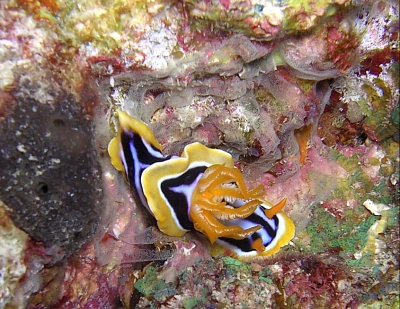
Concerning message #21197:
Dear Bill,
Thanks a lot for your reply.
Frankly speaking I have no scientific experience but I dive frequently and I have a quantity of pics of nudibranchs, crabs, and so on...
Here is another of Chromodoris quadricolor from the same dive laying eggs
Locality: Jeddah, 10 meters, Saudi Arabia, Red Sea, 19 November 2007. Length: 30 mm. Photographer: Vittorio Bruzzone.
Thanks for your reply...
Vittorio Bruzzone
vittorio@bruzzone.it
Bruzzone, V., 2007 (Dec 4) Chromodoris quadricolor and egg ribbon. [Message in] Sea Slug Forum. Australian Museum, Sydney. Available from http://www.seaslugforum.net/find/21245
Dear Vito,
Although experience is valuable, what is equally important is good eyesight and a keen interest in these animals. This message is an excellent example of how interested amateurs with "no scientific experience' can make valuable discoveries. If you look at earlier messages [see #15980] you will see we have been trying to discover just what sort of egg ribbon C. quadricolor has. Two Egyptian biologists in 1959 reported it had an egg ribbon which was attached flat on the rock [see flat-egg ribbons] but no one has ever reported the egg ribbon of this species again. Since 1959 it has become quite important to find what sort of egg ribbon it has because it seems the genus Chromodoris may be a mixture of two or more unrelated groups. One group, which like C. quadricolor has black lines down the mantle, seems to be quite distinct from the others. It has been speculated that C. quadricolor will have a flat egg ribbon and now your photo has confirmed that indeed it does.
Also in the photo is the grey sponge, Semitaspongia, which was present in your earlier message. Many of the 'flat egg ribbon' species eat Semitaspongia or related sponges.
-
Gohar, H. A. F. and Aboul-Ela, I. A. (1959) On the biology and development of three nudibranchs (from the Red Sea). Publications of the Marine Biological Station, Al-Ghardaqa, Egypt 10: 41-62.
Thanks for these valuable photos,
Bill Rudman
Chromodoris quadricolor and the cowrie
November 27, 2007
From: Vittorio Bruzzone
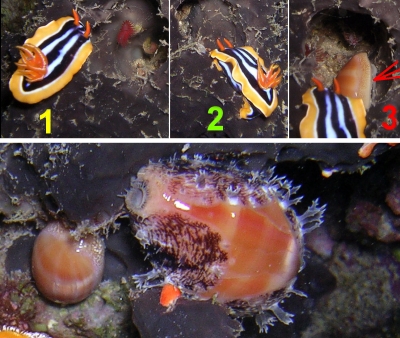
During my diving I took several pictures of Chromodoris quadricolor. I found a relationship between this amazing creature and a species of the snail Cypraea... Observing my photo sequence and the others pics, now I'm curious to know if my observation is correct.
Seems that shell has been delivered by Chromodoris.
Locality: Jeddah, 10 meters, Saudi Arabia, Red Sea, 19 November 2007. Length: 30 mm. Photographer: Vittorio Bruzzone.
Thanks for your reply...
Vittorio Bruzzone
vittorio@bruzzone.it
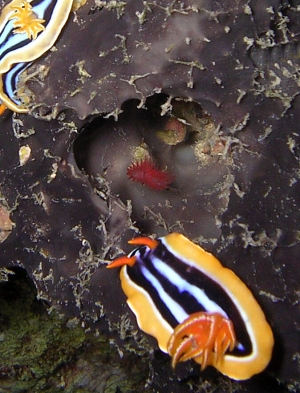
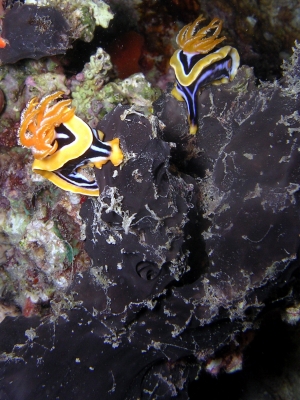
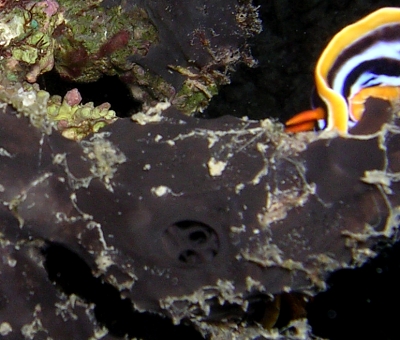
Dear Vito,
I know that for thousands of years the Middle East has been the home of miracles but I don't thinks we need a miracle to explain the apparent production of the cowry [Cypraea sp] by the Chromodoris. In the large photos you sent there were quite a few of this species of Cypraea associated with the grey sponge. To show more detail I have cropped most of the background so in your post we can only see a couple of them close-up. Surprisingly the available information on the biology of cowries is quite limited, some are said to be herbivorous and some are thought to eat sponges. I suspect the species you have found is feeding on the dark grey sponge which fills much of the background of your photos. It is a species of Semitaspongia [Fam: Thorectidae]. In your 1-3 sequence above, I suspect the cowrie was feeding on the sponge and hidden beneath an overhanging ledge in photos 1-2, only becoming visible in photo 3.
What is exciting to me about your message, is not the cowrie, but the grey sponge on which Chromodoris quadricolor is also feeding. If you look at Kamal el Tawil's earlier message [#20150] this is a very interesting observation because previously C. quadricolor had always been associated with a bright red, unrelated sponge of the genus Negombata. Your observation is a valuable confirmation that C. quadricolor feeds on Semitaspongia as well as Negombata
Best wishes,
Bill Rudman
Chromodoris quadricolor feeding?
October 4, 2007
From: Eddy Mannak
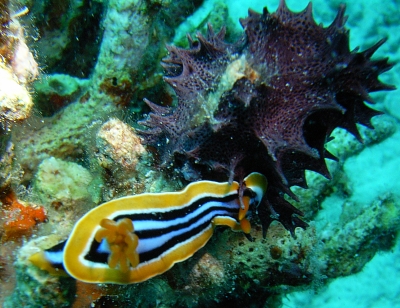
Concerning message #20343:
Hello Bill,
You wrote in this message that you where interested in photos of Chromodoris quadricolor on possible food sponges. During my last holiday in Egypt in August 2007 I did have a special look for you.
And I found one Chromodoris quadricolor eating from a black/purple sponge. So I hope it would be of value to you.
Locality: Hurghada, 11 metres, Egypt, Red Sea , 28 august 2007. Length: 35-40 mm. Photographer: Eddy Mannak.
Greetings,
Eddy Mannak
eddy.mannak@wanadoo.nl
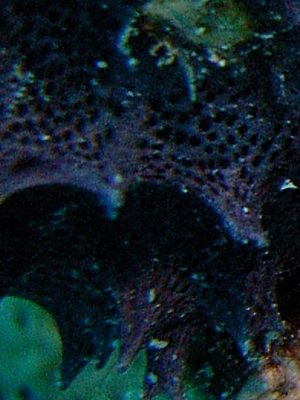
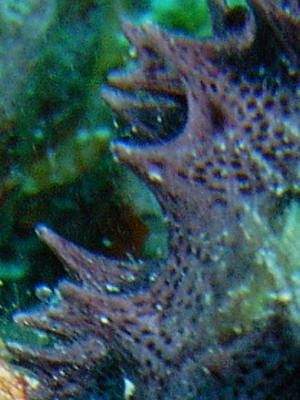
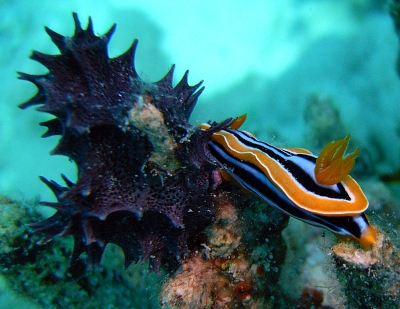
Dear Eddy,
Thanks for thinking of me. Your find is a bit of a puzzle however. Although the purple sponge certainly looks as though it belongs to a sponge family eaten by species of Chromodoris, C. quadricolor is an exception that doesn't seem to eat sponges of this family. In fact the orange-red sponge on the left of your upper photo looks to be the exact sponge that C. quadricolor normally eats. Did you see signs of it actually feeding on the purple sponge?
It will certainly be interesting to see if we get any more observations of it associating with this sponge.
Best wishes,
Bill Rudman
Abnormalities in Chromodoris quadricolor
August 6, 2007
From: Eddy Mannak
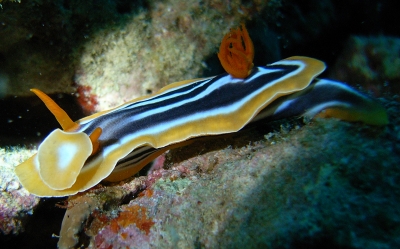
Dear Bill,
I took this photo of Chromodoris quadricolor last June when I was on a diving holiday in Egypt.
You see a lot of these Chromodoris quadricolor here in Egypt, but this one is different. It has an extra flap of mantle in front of one of it's rhinophores. Seems to me he did not had a problem with it, because I never saw a Chromodoris quadricolor so big before. I hope you like the picture and wanted to share it with other people on your forum.
Locality: Hurghada, 25 metres, Egypt, Red Sea, 27 June 2007, El Mina (wreckdive) Length: 60 mm. Photographer: Eddy Mannak.
Greetings from Holland,
Eddy Mannak
eddy.mannak@wanadoo.nl
Mannak, E., 2007 (Aug 6) Abnormalities in Chromodoris quadricolor. [Message in] Sea Slug Forum. Australian Museum, Sydney. Available from http://www.seaslugforum.net/find/20343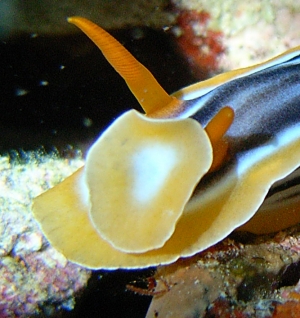
Dear Eddy,
Thanks for this interesting record. In the Abnormalities List we already have three other species of Chromodoris with this same abnormality -Chromodoris kuniei [messages #9996; #9918]; C. willani [ #20241];C. magnifica #10212]. It appears that one cell during development starts producing a piece of mantle edge. As you say, the size of your animal certainly suggests the abnormality is no problem for the animal.
I am interested in your mention of seeing many of this species. If you have photos of it on a possible food sponge I could be useful. It is usually found on a red sponge but in a recent message [#20150] Kamal el Tawil reports it feeding on a dark grey sponge. So any more feeding, or potential feeding, photos would be of value
Best wishes,
Bill Rudman
Chromodoris quadricolor feeding on black sponge ?
July 17, 2007
From: Kamal El Tawil
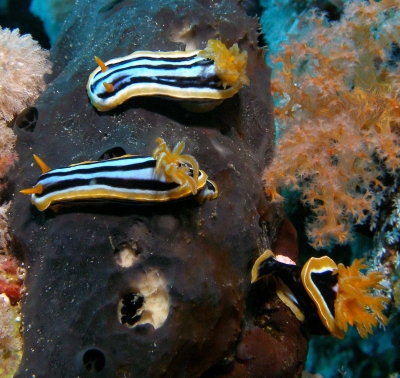
Hello Bill,
On a recent dive trip in Sudan, I found Chromodoris quadricolor feeding on black sponges on various offshore dive sites. I was under the impression that this species fed only on red sponges which are not so abundant in that area as compared to the northern part of the Red Sea. The black sponges are flexible and rubbery like.
Locality: Merlo and Shuab Rumi Reefs, 15 meters, Sudan, Red Sea, April 15th, 2007. Length: 3-4 cms. Photographer: Kamal el Tawil.
Best regards,
Kamal
www.coralworld.net
kamal@coralworld.net
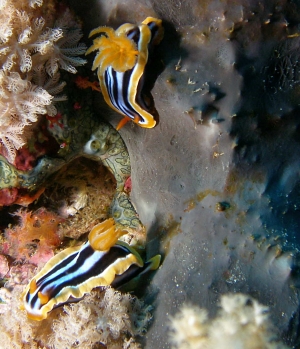
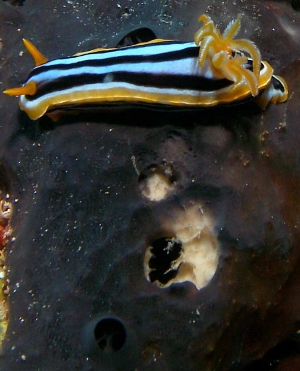

Dear Kamal,
Thanks for the interesting find. The sponge is almost certainly a thorectid of the genus Semitaspongia [see message #16270 showing C. willani feeding]. Up until now C. quadricolor has been reported only from the quite unrelated red sponge Negombata magnifica. That sponge is well known amongst natural products chemists because it produces a very potent group of molecules called latrunculins which are being studied avidly by drug companies world wide. In terms of chromodorid biology, C. quadricolor stores latrunculins in its mantle glands for its own defence. Most species of Chromodoris feed on darwinellid sponges with a completely different suite of defensive molecules so C. quadricolor was a puzzle. However as I discussed at the conference in Bonn last year, and should be published any day, C. quadricolor is one of a group of chromodorid species which feeds on sponges with latrunculins - and they can be found in both Negombata [Podospongiidae, Poecilosclerida] and the quite unrelated Petrosaspongia [Thorectida, Dictyoceratida]. Some species in the western Pacific appear to feed on both a red species of Negombata and a grey-black thorectid. So your find of C. quadricolor feeding on a thorectid Semitaspongia is a valuable correlation. I don't know of any report of latrunculins in Semitaspongia, but C. willani feeds on both the thorectid Petrosaspongia, which does have latrunculins, and Semitaspongia, so we will have to wait until the chemists have a look.
Best wishes,
Bill Rudman
Chromodoris quadricolor from the Red Sea
April 19, 2006
From: Clarke Duncan
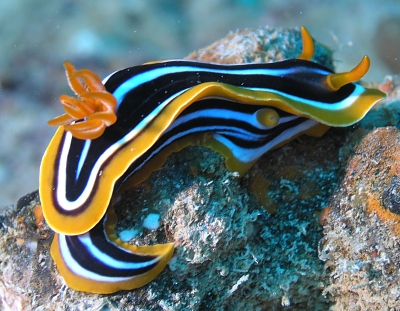
Hi Bill,
Another Chromodoris quadricolor from the Red Sea [see earlier message #16349 ]. This one was located on the port coal bunker on the Thistlegorm, just rear of the superstructure and forwards of the blast area. Initially I thought there were two together as this was my first find of this species and relatively new to spotting nudibranchs, but on further reading realised it was only the one.Thanks once again.
Locality: Thistlegorm Wreck, Northeast of Shag Rock, Shaab Ali, 15 m, Egypt, Northern Red Sea, 11 March 2005, Wreck on sandy bottom. Length: 50 mm. Photographer: Clarke Duncan.
Best regards,
Clarke
clarke_duncan@msn.com
Duncan, C.D., 2006 (Apr 19) Chromodoris quadricolor from the Red Sea. [Message in] Sea Slug Forum. Australian Museum, Sydney. Available from http://www.seaslugforum.net/find/16353Dear Clarke,
This appears to be a colour form of C. quadricolor which I discuss in an earlier message [15098] in which there are traces of black, or black lines, between the orange mantle border and the white band inside.
Best wishes,
Bill Rudman
Chromodoris quadricolor from the Red Sea
April 19, 2006
From: Clarke Duncan
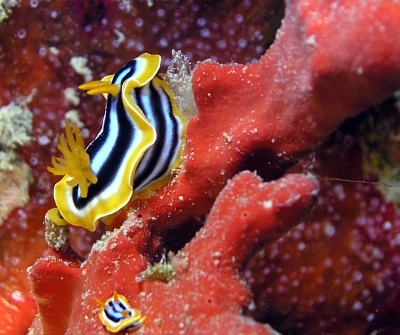
Dear Bill,
On my wreck tour of the Red Sea wrecks this year I have several photos of various Chromodoris nudibranchs. I am aware they can be difficult to identify so I would like you to confirm my thoughts that they are Chromodoris quadricolor as they seem to have the blue that separates them from C. africana.
Locality: 27° 49' 03" N, 33° 55' 14"E. Northeast of Shag Rock, Shaab Ali, Thistlegorm, 20 m, Egypt, Northen Red Sea, 10 March 2006, Wreckage on sandy bottom. Length: 40 mm. Photographer: Clarke Duncan
The upper photo also looks to have a juvenile.
Best regards,
Clarke
clarke_duncan@msn.com
Duncan, C.D., 2006 (Apr 19) Chromodoris quadricolor from the Red Sea. [Message in] Sea Slug Forum. Australian Museum, Sydney. Available from http://www.seaslugforum.net/find/16349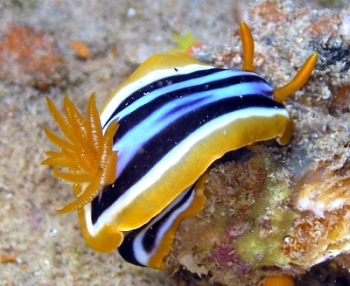
Dear Clarke,
Yes these are C. quadricolor.
Best wishes,
Bill Rudman
Chromodoris quadricolor - behaviour
March 1, 2006
From: Binyamin Koretz
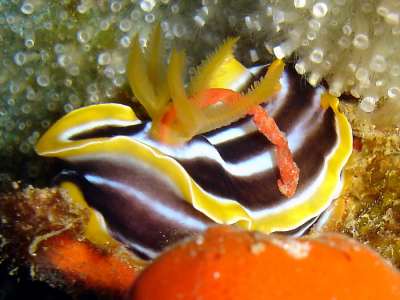
Hi Bill,
This seems to be an observation of the digestive/excretory system of Chromodoris quadricolor in action. Based on the color of the waste product, I guess that the red pigment of its food sponge is not being metabolized.
I'm sure we've seen more than a thousand of these slugs over the years, and we've never once been able to observe its egg-laying or even mating (surprisingly), but at least now we've documented one important bodily function.
Locality: Eilat, Lighthouse Beach, about 30m, Israel, Red Sea (Gulf of Eilat), 24 February 2006, corals. Length: 5 cm. Photographer: Binyamin and Shulamit Koretz.
Best regards
Binyamin
binyamin@koretz.net
Koretz, B., 2006 (Mar 1) Chromodoris quadricolor - behaviour. [Message in] Sea Slug Forum. Australian Museum, Sydney. Available from http://www.seaslugforum.net/find/15980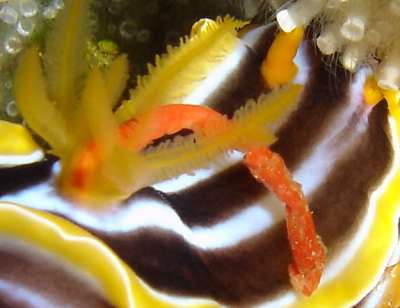
Dear Binyamin,
If we needed further confirmation on its diet, this certainly provides it. Concerning their egg masses, I don't know why I havent mentioned it before, but you may be looking for the wrong thing. Two Egyptian biologists studied some aspects of the biology of C. quadricolor and noted that it had a flattened egg ribbon (Gohar & Aboul-Ela, 1959). I have had difficulty in confirming the identity of their animals because they lacked any blue colouration on the mantle. However, from your photo, it seems probable that C. quadricolor may sometimes lack the blue pigmentation, which makes it confusingly similar to C. africana.
To get back to the egg mass. Have a look at the Fact Sheet on these egg masses, and also look at Scott Johnston's message [#3443] showing C. elisabethina laying an egg ribbon on a red sponge. This type of egg ribbon is much more difficult to see than the normal upright spiral of other dorids. Gohar & Soliman (1967) also reported a similar egg ribbon for C. aspersa (as C. inornata). It would be great if you could find such an egg ribbon asit would be good to confirm their observations.
- Gohar, H. A. F. and Aboul-Ela, I. A. (1959) On the biology and development of three nudibranchs (from the Red Sea). Publications of the Marine Biological Station, Al-Ghardaqa, Egypt 10: 41-62.
- Gohar, H. A. F. and Soliman, G. N. (1967) The biology and development of Chromodoris inornata Pease (Gastropoda, Nudibranchia). Publications of the Marine Biological Station, Al-Ghardaqa, Egypt 14: 77-94.
Best wishes
Bill Rudman
Chromodoris africana or C.quadricolor
February 10, 2006
From: Umut Tural
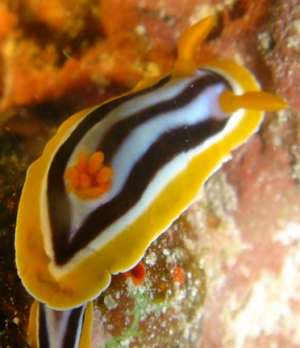
Dear Bill,
I have some difficulities in identifying a specimen of Chromodoris & I'm confused a little. I think I need your help :) This photo was taken 09 of January at Hurghada, in the Egyptian Red Sea. It was crawling on a rock, no feeding observation.
Locality: El Fanadir, North, Hurghada, Egypt, Red sea, 14.4 m, 09 January 2006, Coral reef & sandy plato. Photographer: Dergun Tansel
What do you think? Is it Chromodoris africana or Chromodoris quadricolor?
Thanks.
Best regards
Umut Tural.
umut.tural@gmail.com
Umut Tural, 2006 (Feb 10) Chromodoris africana or C.quadricolor . [Message in] Sea Slug Forum. Australian Museum, Sydney. Available from http://www.seaslugforum.net/find/15767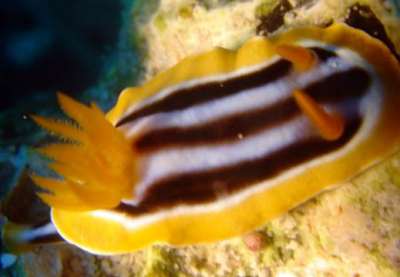
Dear Umut,
Yes these can be confusing. They are easy to tell apart if you have them together, because C. africana has a wider mantle skirt. The other good way is to remember that 'quadricolor' is Latin for '4 colours' so if you animal has blue, orange, black and white then it is most probably C. quadricolor. If it doesn't have blue, and has a wide mantle skirt, it is most probably C. africana.
One problem is that in photos, the blue can often be 'washed out' of the photo or be very pale. I'm afraid there's not much we can do about that. Your animal is definitely C. quadricolor.
Best wishes,
Bill Rudman
Chromodoris quadricolor from Egyptian Red Sea
November 30, 2005
From: Chris Dekker
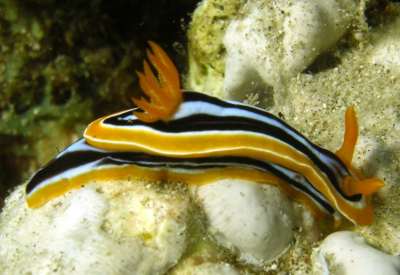
As I am very interested in these beautiful sea slugs, I always look for them while diving. Hereby I send you a photo I took of what I think, was Chromodoris africana (you can correct me if I am wrong).
Locality: Sharm Abu Dabbab north, Egypt. Red Sea. Depth: 4 meters. Length: about 30 mm. 20 October 2005. very good site for photos. Photographer: Chris Dekker
Greetings from Chris Dekker
(from The Netherlands)
cwhdekker@planet.nl
Dekker, C.W.H., 2005 (Nov 30) Chromodoris quadricolor from Egyptian Red Sea. [Message in] Sea Slug Forum. Australian Museum, Sydney. Available from http://www.seaslugforum.net/find/15380Dear Chris,
It is definitely a Chromodoris, and is one of a group of similarly coloured species which includes C. africana. However your animal is a typical example of another species in the group - Chromodoris quadricolor. The name means '4 colours'. I know black and white are not really colours, but when Ruppell & Leuckart named this species in 1828, the true nature of colour had not been discovered - and most people would still consider a black, white, orange and blue animal to be 'four-coloured'.
Best wishes,
Bill Rudman
Re: Is this also Chromodoris quadricolor?
November 5, 2005
From: Binyamin Koretz
Dear Bill,
Along with Chromodoris kuiteri, I would also cast doubt on Chromodoris hamiltoni being in the Red Sea, or at least at this end of it. Ilan's animal [message #9457] seems to me to be what we are calling Chromodoris strigata and not Chromodoris hamiltoni. In his photo that you suggested might be C. hamiltoni, you can clearly see the characteristic dark translucent spots on the mantle, which generally run to bluish in the Red Sea.
Jacob's question [message #15098] further highlighted one of our constant slug issues in Eilat: distingushing between Chromodoris africana and Chromodoris quadricolor. The former is relatively rare and possibly seasonal (spring) while the former is common year-round. Based on your answer, I would guess that the majority of "africana" sightings here are really C. quadricolor, something that I suspected anyway.
Best regards
Binyamin
binyamin@koretz.net
Koretz, B., 2005 (Nov 5) Re: Is this also Chromodoris quadricolor?. [Message in] Sea Slug Forum. Australian Museum, Sydney. Available from http://www.seaslugforum.net/find/15123Dear Binyamin,
I suspect now that all the animals in Ilan's message are C. quadricolor. The basic difference in colour between C. quadricolor and C. africana is that C. quadricolor, as its name describes, has 4 'colours' - blue, white orange, black - while C. africana does not have blue. Unfortunately in photographing these animals the blue can be lost so trying to identify animals solely from photos can be very difficult. In living animals, apart from the colour, the shape of the bodies is quite different with C. quadricolor being relatively narrow with a straight sided, and fairly narrow, mantle skirt. C. africana, on the other hand has a broad oval shaped mantle with a wide mantle skirt. I must admit that at times I cannot resolve the indentity of some of these species from the photos. Unfortunately, the lack of blue in a photo does not necessarily mean the animal lacked blue.
Best wishes,
Bill Rudman
Is this also Chromodoris quadricolor?
October 25, 2005
From: Jacob Dafni
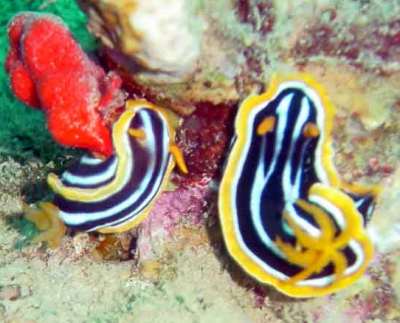
Dear Bill,
In the northern Red Sea we have already identified, aided by your guidance, five species of the C. quadricolor complex: , Chromodoris quadricolor, C. hamiltoni, C. kuiteri, C. africana and lately also C. strigata.
Locality: Meridian Beach, Eilat, Israel. Red Sea. Depth: 8-14 m. 12 September 2003. Coral rubble. Photographer: Michael Levin
I wonder whether the attached slug, photographed by Michael Levin in 2003, which I maintained to be a unconventional color variation of C. quadricolor, is not C. magnifica? Typically, this last species exhibits more stripes, and in the Philippines or PNG it shows different color patterns, but pictures exhibited in your forum, such as (1) your picture from Heron Island, 1983 and (2) your identification of a picture taken by Clay Bryce in W. Australia in April 26, 1999, may suggest that the attached is also C. magnifica. Would you comment on this?
Jacob
jdafni@netvision.net.il
Dafni, J., 2005 (Oct 25) Is this also Chromodoris quadricolor?. [Message in] Sea Slug Forum. Australian Museum, Sydney. Available from http://www.seaslugforum.net/find/15098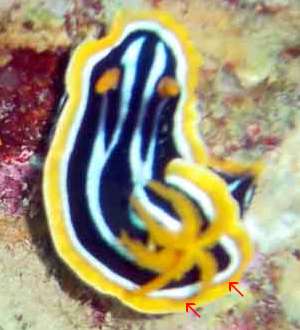
Dear Jacob,
I am sure as I can be that these are C. quadricolor. There is a distinct bluish tinge in the white bands. One feature that distinguishes C. magnifica is that its orange border is definitely submarginal. There is a distinct white band right at the edge. In some photos of C. quadricolor there appears to be a white band at the edge, but it is much narrower and is an artifact of photography, the thin edge appearing colourless.
It is interesting that the larger animal shows a hint of black between the orange border and the inner white band at the posterior end of the mantle - a bit like in C. kuiteri? Perhaps the animal in Matan Ninio's message [#14975], which I identified as C. kuiteri, is in fact an even blacker form of C. quadricolor. I am not that comfortable with the idea that C. kuiteri occurs in the Red Sea, since we have no other records of it in between.
There are always going to be puzzles when you get a group of very similar looking species in one geographic area. I have found there is a time when learning about the biology of the populations is probably more useful than looking again at the anatomy. So all I can say is try and get photos of the various colour forms mating, feeding, laying eggs etc.
Best wishes,
Bill Rudman
Chromodoris quadricolor - strange behaviour
October 7, 2005
From: Kamal El Tawil
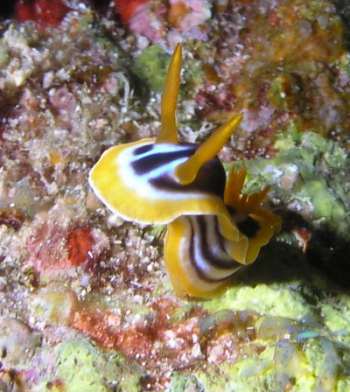
Dear Bill:
I know this may sound strange, but do you think a nudibranch like Chromodoris quadricolor can react to the presence of a large prey or a diver ?
When I approached one last week, it seemed to "stand up" on its rear end. is this a matter of coincidence ?
Kind regards
Kamal
Cairo, Egypt
kt@tedata.net.eg
El Tawil, K., 2005 (Oct 7) Chromodoris quadricolor - strange behaviour. [Message in] Sea Slug Forum. Australian Museum, Sydney. Available from http://www.seaslugforum.net/find/14937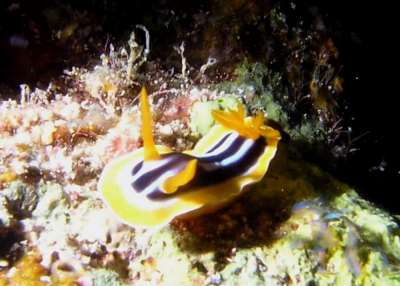
Dear Kamal,
Have a look at my comments on an earlier message [#8367] for an answer. It's possible your pressure wave as you got close to it lifted its head and caused it to start its normal waving behaviour, or you may have just caught it by coincidence. This waving of the head is one way these animals can 'sense' interesting molecules in the water. When the wind is blowing, my dog often cranes its head in the air and waves its head around sniffing - doing much the same thing I guess. In the case of the slug, its rhinophores are its nose.
Best wishes,
Bill Rudman
Chromodoris quadricolor from Egyptian Red Sea
June 6, 2005
From: Kamal el Tawil
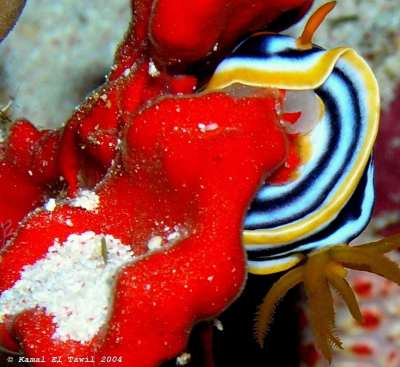
Dear Bill,
I stumbled on your website. I have a few pictures that can be of use, so I thought why not share with all participants of this Forum. Here is Chromodoris quadricolor.
Locality: Jackson Reef, Straight of Tiran, Egypt, Red Sea. Depth: approx 20 mt. 03 September 2004. Photographer: Kamal El Tawil
Kamal El Tawil
ktawil@yahoo.com
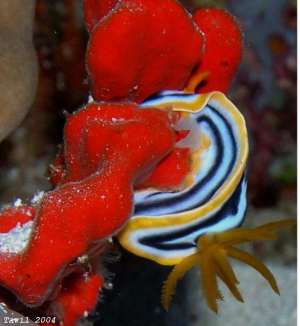
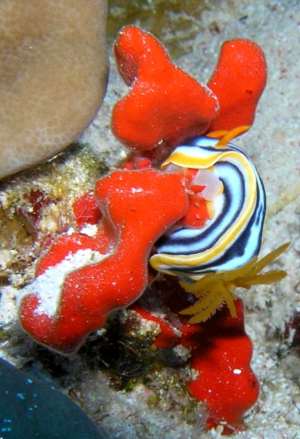
Dear Kamal,
Thanks very much for these photos. Apparently Chromodoris quadricolor either eats a number of species of red sponge, or there is one species with many different growth forms. The lobulate form of the colony in your photos is rather different from the long branching colonies it is usually photographed on. It is an interesting observation.
Best wishes,
Bill Rudman
Chromodoris quadricolor from Egypt
March 25, 2005
From: Matan Ninio
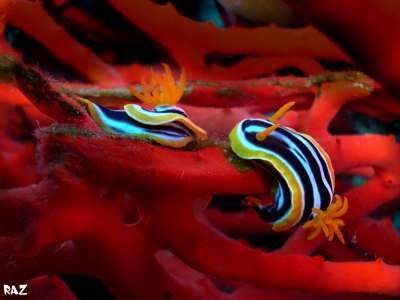
I reponse to your comments [#13338] here is a nice picture of Chromodoris quadricolor on its food sponge, from Taba, the northern tip of the Egyptian Red Sea (some 400m south of the Israeli border).
Locality: Taba, "The Canyon". Egypt, Red Sea. Depth: 15-20 m. Length: 45 mm. 19 March 2005. Coral. Photographer: Razi (RubberDuck) Cohen
Matan Ninio
matan@forumhasofiot.yam.dive.ninio.org
Ninio M., 2005 (Mar 25) Chromodoris quadricolor from Egypt. [Message in] Sea Slug Forum. Australian Museum, Sydney. Available from http://www.seaslugforum.net/find/13408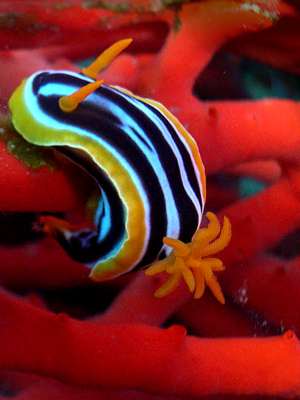
Dear Matan,
Thanks for the photo. This red sponge has usually been identified as a species of Latrunculia, but the advice I have is that it is more likely to be a species of Clathria, a quite different family of sponges. So any photos showing the detail of the sponge and the shape of the colony are very welcome.
Best wishes,
Bill Rudman
Chromodoris quadricolor from the Red Sea
March 16, 2005
From: Binyamin Koretz
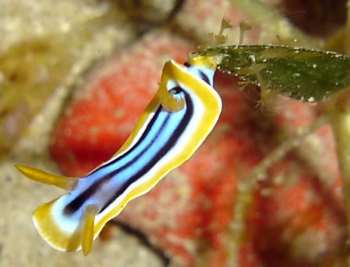
Hi Bill,
As you probably know, Chromodoris quadricolor is the most plentiful opistobranch in Eilat, appearing in large numbers at all depths (to 45m at least), in all seasons, at all times of day, etc. But we've never seen one doing this before, and I was hoping you could explain the trick: This (relatively small) one had somehow attached himself to a blade of sea grass and was just "hanging out". What do you think?
Locality: Eilat, Village Beach, Israel, Red Sea. Depth: 23 m. Length: 2 cm.11 March 2005. sea grass, occasional coral heads. Photographer: Binyamin and Shulamit Koretz
Best regards
Binyamin
binyamin@koretz.net
Koretz, B., 2005 (Mar 16) Chromodoris quadricolor from the Red Sea. [Message in] Sea Slug Forum. Australian Museum, Sydney. Available from http://www.seaslugforum.net/find/13338Dear Binyamin,
When we move around our main way of seeing where we are going, is our sight. The eyes of nudibranchs can't form images, so to a large extent they are reliant on the sense of touch and the sense of smell. When they are crawling along and come to the 'end' or edge of what they are crawling on, they often extend out as far as they can go and then wave around hoping to make contact with another object on which to crawl. Caterpillars do something similar. They also use their paired rhinophores to 'smell' chemicals in the water [rhinophore = 'nose carrier']. If they sense something interesting, perhaps molecules produced by their food sponge, they are able to take aim toward the source of the interesting chemicals. Many sighted animals take aim at their prey by waving their head like this to get the distance right. So while they seem to be just 'hanging out' their little brains are probably working overtime.
Your mention of Chromodoris quadricolor being very common raises the possibility that you and your fellow enthusiasts could try and answer a few simple questions about this and the similarly coloured species of chromodorid in your part of the world. It would be very useful to have some photos of their egg ribbons and their food sponge. If there is more than one species perhaps we can see some egg ribbon differences and even food sponge differences.
Best wishes,
Bill Rudman
'Pyjama slugs' from the Red Sea
May 21, 2003
From: Ilan Ben Tov
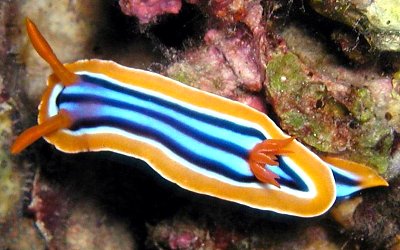
Dear Bill,
In the northern Red Sea, at Eilat, on one dive I took pictures of the following 3 slightly different slugs. We call all these 'Pyjama slugs', but I was able to isolate 3 different species.
Chromodoris elisabethina
Chromodoris kuiteri
Chromodoris quadricolor (usually found on red sponges)
According to my knowledge the first two are Australian species. Could they be found in the northern Red Sea? Are they indeed different or they all the same?
Photos taken at Eilat, Gulf of Aquaba, Red Sea, March 15th, at depth of 27m.
Upper Right: Is it Chromodoris quadricolor? This slug is very common in Eilat in the Red Sea. It is found from depths of 5m to 30m and probably deeper usually on top of red sponges that it feeds upon.
Lower Left: Is this Chromodoris kuiteri?
Lower Right: Is this Chromodoris elisabethina?
Ilan
ilanbt@gilat.com
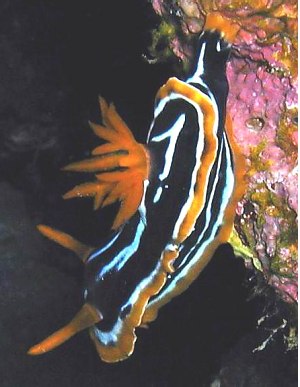
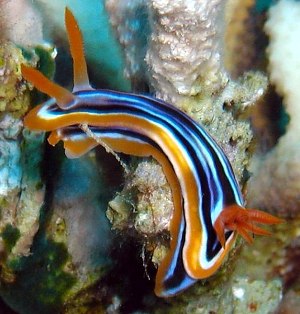
Thanks Ilan,
I agree you probably have 3 species here. The upper right one is C. quadricolor and its red sponge seems to be a good 'field character' to use in its identification.
The lower left animal is most probably Chromodoris africana. It looks a bit different from the animals I am familiar with from East Africa which have quite a wide mantle skirt. It ceraubly has similarities to C. kuiteri but I would be very surprised if that northeastern Australian species also occurred in the Red Sea. If you animal is C. africana then I have to look again at Erwin Koehler's photo which I previously said must be C. quadricolor. Perhaps it is C. africana in whih the white has a bluish tinge. I really can't be sure at this stage.
The lower right animal is most probably the Indian Ocean 'counterpart' of C. elisabethina, C. hamiltoni.
If you are interested in doing a bit of research with these animals it would be great to know just what sponges each of these 'species' eats and what their egg ribbons look like. It might take you a year or so to be lucky enough to atually catch them feeding or laying eggs but it would be a very useful piece of information and would certainly help clarify the differences between these 'Pyjama Slugs'.
Best wishes,
Bill Rudman
Chromodoris quadricolor or C. magnifica
March 10, 2003
From: Marina Poddubetskaia
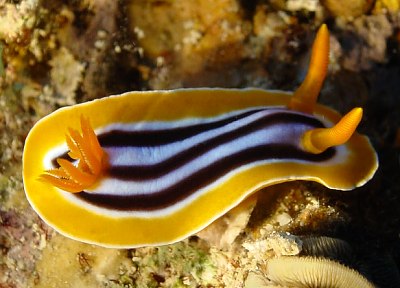
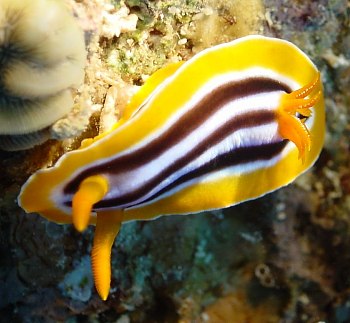
Dear Bill,
I’m just back from Southern Red Sea diving cruise, near Brothers Islands. I saw there many more sharks than nudibranchs, but somehow I found some species. I would like to reopen the discussion about the specimens of Chromodoris quadricolor I found a year ago in the Northern Red Sea. I think, the specimens I found in the South are the same and they seem to be quite common also. But now, my photos are better.
In my specimens the orange band can be said submarginal and they seem to fit a little the description of Chromodoris magnifica. So, the confusion persists. So, I’d like to have your opinion on these new photos. Thank you in advance.
Date: February 08, 2003
Location: Safaga, Egypt, Red Sea
Site: Tobia IV
Depth: 11m. Size: about 55mm
Photos: Marina Poddubetskaia - Nembro website
Best wishes,
Marina.
nembro@nembro.info
Poddubetskaia, M., 2003 (Mar 10) Chromodoris quadricolor or C. magnifica. [Message in] Sea Slug Forum. Australian Museum, Sydney. Available from http://www.seaslugforum.net/find/9240Dear Marina,
I hope as more photos are added that we can alleviate any confusion. In C. magnifica there is a distinct white outer band on the mantle while in C. quadricolor there can be a thin whitish edge to the mantle. Usually its translucent or uncoloured and I think the way it appears in photos is dependent on the way it is lit when photographed. In general terms the mantle in C. quadricolor is more elongate, with a relatively narrow mantle skirt while in C. magnifica the mantle is more ovate with a relatively wide mantle skirt.
The photos in your second message are also C. quadricolor.
Best wishes,
Bill Rudman
Chromodoris quadricolor or C. magnifica (2)
March 10, 2003
From: Marina Poddubetskaia
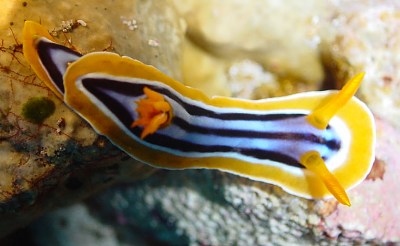
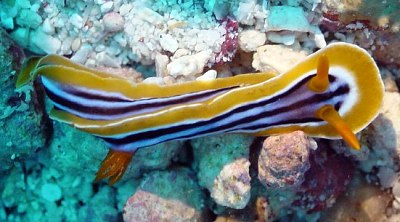
Dear Bill,
In relation to my first message, here are my second group of photos.
February 12, 2003
Location: Brothers Islands, Egypt, Red Sea
Site: Southwestern Small Brother
Depth: 22m. Size: 35-40mm
Photos: Marina Poddubetskaia - Nembro website
Best wishes,
Marina.
nembro@nembro.info
Poddubetskaia, M., 2003 (Mar 10) Chromodoris quadricolor or C. magnifica (2). [Message in] Sea Slug Forum. Australian Museum, Sydney. Available from http://www.seaslugforum.net/find/9241Dear Marina,
I have no doubt that these are also Chromodoris quadricolor.
Best wishes,
Bill Rudman
Chromodoris quadricolor/africana from Jordan
December 14, 2002
From: Erwin Köhler
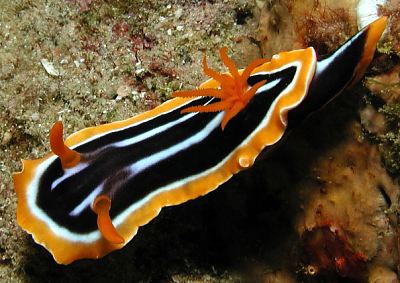
Dear Bill,
To follow up on my earlier photos, here is a picture from Jordan, Aqaba. The general impression of this one was very dark, compared with many other Chromodoris quadricolor. So I thought it was Chromodoris africana, but it has a pale blue background in the middle, this could make it to Chromodoris quadricolor. It much larger than others of this group.
Size: 54mm
Depth: 18m
Date: 8 November 2002
Divesite: "Kiwi Reef"
Erwin
Erwin@medslugs.de
Köhler, E., 2002 (Dec 14) Chromodoris quadricolor/africana from Jordan. [Message in] Sea Slug Forum. Australian Museum, Sydney. Available from http://www.seaslugforum.net/find/8580Dear Erwin,
I am sure this is Chromodoris quadricolor. The blue is the '4th colour' which gives this species its name. C. africana grows to a larger size and has a much more extensive mantle skirt than C. quadricolor. In an earlier reply to a message from Jochen Scholtyssek I identified some photos as being C. africana, and suggested some of identifications Debelius' of this species were incorrect. On reflection I think the blue colour is often lost in printing and his animals on the red sponge are C. quadricolor. It would be good to get some more photos of unambiguous C. africana on its food sponge to see if we can find another way of telling these two apart. It would be good if we could say with certainty that C. quadricolor, but not C. africana, fed on this red sponge.
Best wishes,
Bill Rudman
Chromodoris quadricolor from Jordan
December 10, 2002
From: Erwin Köhler
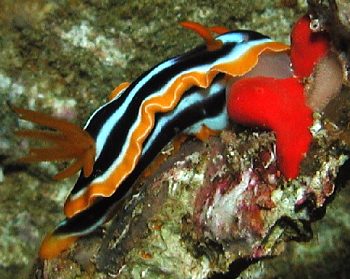
Dear Bill,
Here are some pictures from Aqaba, Jordan. I think they are of Chromodoris quadricolor, though the blue background in the middle is often pretty pale, almost white.
Upper Right: feeding. Size: 24mm, Depth: 23m, 10 November 2002. Divesite: wreck of the "Cedar Pride"
Lower Left: head. Size: 38mm, Depth: 25m, 13 November 2002. Divesite: "Saudi Border"
Lower Right: Size: 27mm, Depth: 14m, 15 November 2002. Divesite: "Cazar Reef"
Erwin Koehler
Erwin@medslugs.de
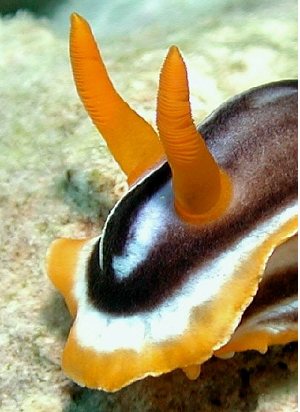
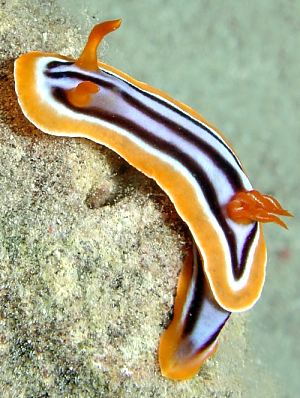
Thanks Erwin,
Yes this is C. quadricolor. Thanks for the photo of it with its oral tube everted over the bright red sponge. This can definitely count as a feeding record.
Best wishes,
Bill Rudman
Chromodoris quadricolor from Egypt
October 1, 2002
From: Michael Mrutzek
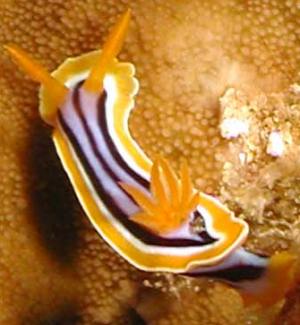
Dear Bill,
Here is a photo of another slug from the Red Sea for use in the Forum.
Data: Godda Left, 20 meters, off Hurghada, on the Red Sea coast of Egypt, August, 2002. Photo: Copyright Michael Mrutzek.
Michael
Mrutzek@meeresaquaristik.de
Mrutzek, M., 2002 (Oct 1) Chromodoris quadricolor from Egypt. [Message in] Sea Slug Forum. Australian Museum, Sydney. Available from http://www.seaslugforum.net/find/8035Dear Michael,
This is Chromodoris quadricolor.
Best wishes,
Bill Rudman
Chromodoris quadricolor? from the Red Sea
April 27, 2002
From: Marina Poddubetskaia
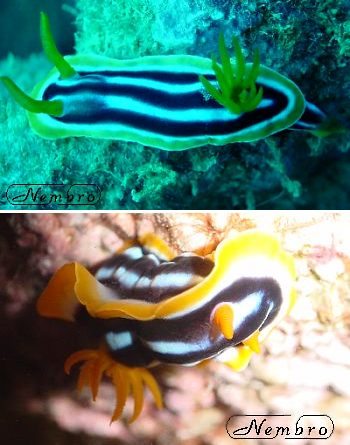
Dear Bill,
Here are some chromodorids I photographed at the end of March when I spent a week in Egypt. It was a dive cruise at the North of Red Sea, between Hurghada and Sinai mountains.
I have left the most interesting, which I have identified as Chromodoris quadricolor, until the end. It was present at all sites, between 2 and 22m. Local books call it Ch. quadricolor or Chromodoris pyjama(?!). But it also looks like Ch. africana or Ch. magnifica. I don't see the difference between these 3 species. Could you let me know what they are?
The most common form has 2 regular white/blue middle bands. Sorry, but I didn't note that I didn't take enough photos of this form (any with back view). But there are other forms (or species ?). I think there is a transformation : it begins with the partition of middle bands from 2 to 4. In local books I saw the photos of these guys in which the top (near rhinophores) of 3rd band joins the bottom (near gills) of 2nd band. The final step of this transformation is the photo you have identified as C. strigata.
Thank you for your help.
Best wishes,
Marina.
marina.poddubetskaia@francetelecom.com
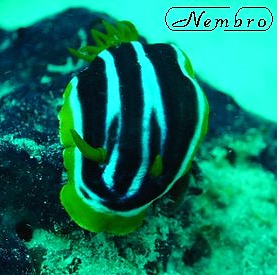
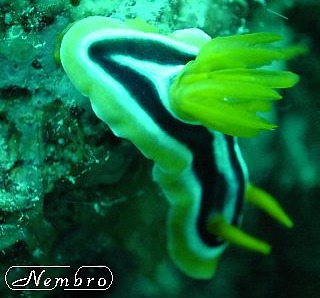

Dear Marina,
I think we still have a few things to sort out with the black-lined chromodorids of the Red Sea region. The most important thing to realise is that in certain parts of the world some of the local chromodorids have evolved to mimic the colour patterns of each other. See the page on mimicry on chromodorids. Outside the Red Sea, the distinction between Chromodoris quadricolor and Chromodoris africana is quite clear. C. quadricolor is quite elongate with a relatively narrow mantle skirt down each side, while C. africana has a softer body, and the wide mantle skirt is much thinner in thickness (ie: much less rigid to the touch). In colour they are quite different, C. quadricolor, as it name suggests has four 'colours', [black, white, blue, orange] not the three [black, white, orange] of C. africana. In 'typical' C. quadricolor there is only a very thin line separating the orange border from the outermost black bands. I have included alongside a copy of the original painting of C. quadricolor (Rüppell & Leuckart, Pl.9, fig. 2).
Most photos I have seen from the Red Sea suggest that in that region the white line between the outer black band and the orange border is not as narrow as in specimens from East Africa, or as wide as in C. africana. It also seems that the blue background colour in the central region can sometimes be absent. The Indo-West Pacific species, C. magnifica differs in having a submarginal rather than marginal orange border. The splitting of the black bands into thinner secondary bands appears to occur in a number of species.
So how can we be sure which is which? I have described radular differences, but that is not a practical way to identify them in the field. I think we need to know more about their biology. Do they all eat the bright orange red sponge they are often photographed on?, what are their egg ribbons like? etc. The only study of a large population was Gohar & Abul-Ela's (1959) who studied 'several hundred specimens'. Unfortunately I am not sure if they were studying C. quadricolor or C. africana as they describe then as having bluish-black and white bands, which suggests C. africana. Whatever species they had it is interesting that they note that the egg ribbon was flat as reported for many of the C. quadricolor colour-group in the western Pacific.
Some of Marina's photos have blue in the central region, some do not. There is of course another possibility, and that is that this common animal often photographed on the red sponge is a third unnamed species mimicking both C. africana and C. africana. Which only brings me back to the need for more information on their food. Has anyone got photos of what I consider 'typical' C. quadricolor and C. africana on sponge? It would be nice to get some indication that they eat something different.
Concerning 'Chromodoris pyjama' - I think this is an invented name.
References:
• Gohar, H.A.F. & Aboul-Ela, I.A. (1959) On the biology and development of three nudibranchs (from the Red Sea). Publications of the Marine Biological Station, Al-Ghardaqa, Egypt, 10: 41-62. (Pls.1-5)
• Rüppell, E. & Leuckart, F.S. (1830 or 31) Neue wirbellose Thiere des Rothen Meeres. Atlas zu der Reise im nördlichen Afrika von Eduard Rüppell. Brunner, Frankfurt am Main. 23-50, pls 7-12 pages.
Sorry I can't give you a definitive answer but perhaps it will encourage visitors to the Red Sea to try and find blue-banded and white-banded 'C. quadricolor' together on the photogenic Red Sponge or even better 'C. quadricolor', of any colour, on a sponge other than the famous red one.
Best wishes,
Bill Rudman
Chromodoris quadricolor from Saudia Arabia
April 2, 2001
From: Larry Dupriest
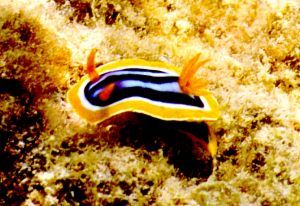
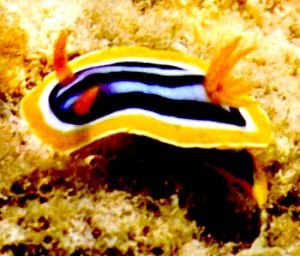
These photos were taken in the summer of 2000 along the Red Sea shoreline about 100 km north of Yanbu, Saudi Arabia (near the Yanbu Cement Plant). This is an area where the coral reef parallels the shore about 75 feet out. The reef is a vertical 50' drop of live coral teaming with fish varieties. These nudi's were found in the 2-3 feet deep shallows about half way out to the reef.
I have sent the C. elisabethina photo because of Cody's question about its food. It will give Cody an idea of the mossy areas where these are commonly seen. Is this a food source?
Larry Dupriest
dgdupriest@gtis.net
Dupriest, L., 2001 (Apr 2) Chromodoris quadricolor from Saudia Arabia. [Message in] Sea Slug Forum. Australian Museum, Sydney. Available from http://www.seaslugforum.net/find/4104Dear Larry,
Thanks for the photo. The animal is in fact Chromodoris quadricolor rather than Chromodoris elisabethina which seems to be confined to the western Pacific. Concerning the 'mossy' stuff your animal is crawling on. That is algae (sea weed) and just because the nudibranch is crawling over it, it does not mean that it eats it. C. quadricolor, like all species of chromodorid is a specialised sponge feeder. Sometimes, when it eats out a colony, it has to go for a walk to find a new sponge colony. Or perhaps it is looking for a mate?
Could you let me know what 'summer' means? I prefer to have a month so that there is no ambiguity.
Best wishes,
Bill Rudman
Chromodoris quadricolor? from the Red Sea
January 8, 2001
From: Erwin Koehler
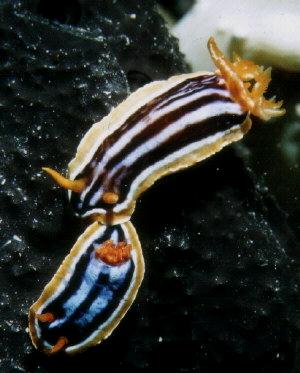
Dear Bill,
this one is from the Red Sea, made by Ingolf Feilhaber,
Email: I.Feilhaber@t-online.de
Size, depth, date are not recorded
Are they Chromodoris quadricolor or Chromodoris africana.
Erwin
Medslugs.Koehler@t-online.de
Koehler, E., 2001 (Jan 8) Chromodoris quadricolor? from the Red Sea. [Message in] Sea Slug Forum. Australian Museum, Sydney. Available from http://www.seaslugforum.net/find/3248Dear Erwin,
Thanks for the photo. While answering your message I found I had half-completed a page on C. quadricolor last May. So this was a good excuse to finish it. Yes it is C. quadricolor.
Best wishes,
Bill Rudman
Chromodoris africana from Red Sea
July 7, 2000
From: Jochen Scholtyssek
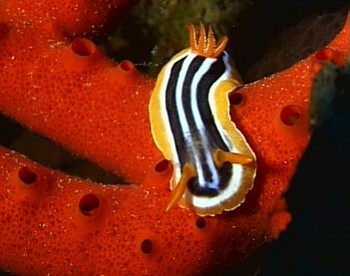
Dear Bill,
Here are some Video-Pictures for you of a nudibranch from the Red Sea.
April 2000. ROYAL Diving Center, Akaba, Jordan. Depth 15m.
Best wishes,
Jochen Scholtyssek
joscholty@t-online.de
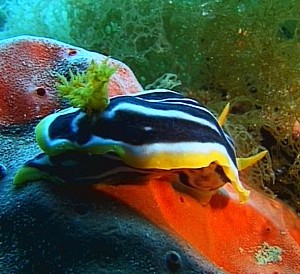
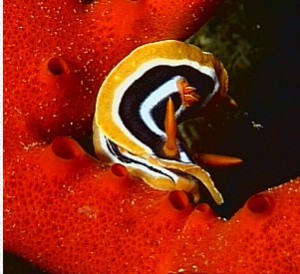
Note: I now think Jochen's photos [and Debelius'] are of C. quadricolor. See my comments in later message. I suspect the red sponge is the food choice of C. quadricolor, and if you look carefully traces of blue can be seen in the central region of the mantle. Dec 14. 2002 .. Bill Rudman
Dear Jochen,
This is Chromodoris africana. It is often photographed on this orange-red sponge which Debelius identifies as Latrunculia magnifica in his book. He identifies this animal as Chromodoris quadricolor, but that species has a blue background colour on the central part of the mantle and a very thin white line separating the black bands from the orange border.
Best wishes,
Bill Rudman.
